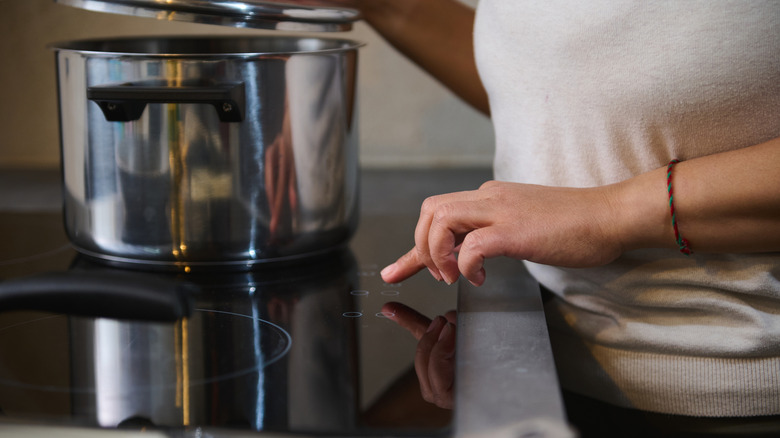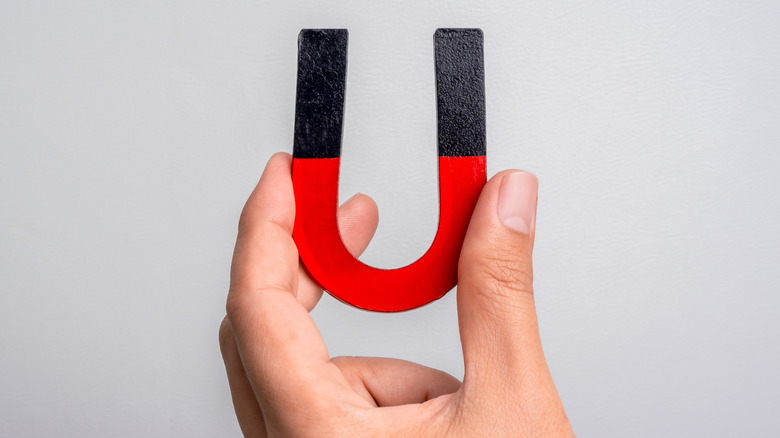The Induction Stovetop Mistake That Can Be Solved By A Magnet
If you're a newcomer to induction cooking, you might be wondering if it's okay to use your favorite old pot or pan on your new stove. That trusty aluminum pot has worked for you for years, so it should work now, right? Unfortunately, if you try to use most copper, ceramic, or aluminum cookware on an induction stove, you'll probably end up with a room temperature dinner. So, how do you avoid this? One word: magnets!
Before you get cooking, take any small magnet you have lying around the house and try sticking it to the bottom of your pot or pan. If the magnet holds fast to the surface, then that pot or pan should work just fine. If it doesn't, then you're out of luck and will need to find a different cooking implement — or, order some takeout. Then, the next time you're choosing the right cookware to buy, take a magnet with you and magnet-check everything you consider. That way, you'll be sure you're investing in cookware that you can actually use.
How induction cooking works
The reason you want to magnet-check your prospective cookware is simply because induction stoves use magnets, too. Unlike gas or electric coil stoves, induction surfaces utilize a magnetic field generated by a coiled wire beneath a flat, glass-ceramic panel to create heat. The pot or pan sitting on top receives an electrical current, which converts into heat within the cookware itself, through resistance. This means that induction-friendly cookware must have a ferromagnetic base, like iron or steel. Ferromagnetic materials adhere strongly to magnets, so if your favorite pot or pan sticks solidly to a magnet, then it should work on your induction stove, too.
As some cities say goodbye to gas stoves in favor of more energy-efficient cooking, induction is seeing some serious growth in popularity. It heats up fast, features precise temperature controlling, and can be safer than cooking with an open flame. The cooking surface only heats up if there is a pot or pan on it, meaning the stove itself is less likely to cause burns when touched, or start kitchen fires. While all that means it's easier to find induction-friendly cookware in stores nowadays, it still pays to double-check for magnetism when buying anything new. Even if you don't have an induction stove now, this technology may well be the future of home cooking.
A caveat to the magnet test
An important thing to remember here with the magnet method is that it should cling steadily and fully without sliding or slipping. If it does slide off, that likely means the metals in the cookware are blended, or are impure, to the point where they are not fully ferromagnetic. This impurity results in poor compatibility with induction stovetops.
It's also worth noting that some pots and pans only have an iron or steel bottom, while the rest of the pot consists of other metals. The non-magnetic parts of this cookware may not heat up as evenly as the base, resulting in cool areas and unevenly cooked food. As long as you watch out for these caveats, the magnet trick helps ensure your kitchenware is right for your needs.
If you don't want to throw out your favorite non-magnetic pot or pan, don't worry! Purpose-built metal converter discs act as a go-between for copper or aluminum cookware and induction stoves. These lower-efficiency ferromagnetic discs become very hot when in contact with induction. While this somewhat negates the safety benefits of induction cooking because of the heat, the disc functions similarly to a normal electric coil stove surface. So, even if you don't have steel or cast iron cookware, you can still do some serious one-pan weeknight meal cooking on your induction stove.


